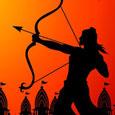History of Navratri
How many are actually aware of the history that is duly associated with the celebration of Navratri? Well if you are not then you should surely go through the article enlisted below. By reading this article will surely enlighten yourself with the history associated and the legends associated with the celebration. After reading click here to forward this page to your loved ones so that they as well become acquainted with the history associated.
The historical background
Navratri or the Festival of Nine Nights from Ashvin Sud 1 to 9 is devoted to the propitiation of Shakti or Divine Mother. She represents prakriti, responsible for creation of the world according to the religious ideology of Goddess worship.
There are two interesting legends or epics associated with the history of Navratri and celebrated across the country with great reverence and faith taking on different names and idols.
Battle of good over evil
Legends prevalent in North Indian :
Lord Brahma of the trinity Brahma, Vishnu & Maheshwara, granted Mahishasura the "buffalo demon," a boon that protected him from any man in the world . Empowered by this gift, Mahishasura set out to conquer the world, heaven and the world, and brought about the defeat of the king of deities,Indra. At the pleading of Indra, the king of the Gods, Lords Brahma, Vishnu and Shiva created Devi Durga, by combining their own divine powers (shakti). Endowed with the trinity's shakti, Durga proved to be a formidable opponent who fought Mahisa for nine days, beheading him on the tenth. The nine nights known as Navratri, symbolize the nine days of battle between Devi Durga and Mahisasura, while the tenth day, which is vijayadashami-literally means the victorious tenth day of conquest of good over evil.
In West Bengal Navratri, and vijayadashami are respectively celebrated as Durga Puja and Dasara.
In South India the festival includes other female deities an dedicates three days of the festival to Lakshmi, the female archetype of wealth and fortune, and another three to Saraswathi, the female archetype of learning, music and knowledge.
In northern India it takes the form of the great epic Ramyana where Rama, an incarnation of Vishnu is victorious over the evil king Ravana.
Lord Shiva's dance of destruction (tandav)
The Eastern Belief :
Daksha, the king of the Himalayas and the plains, and his wife, Menaka, had a daughter called Uma. Uma, was a devotee of Shiva since she was a child.She worshipped the Lord as her husband. Shiva, satisfied by her devotion and faith agreed to marry her. Daksha did not approve of a tiger-skin clad groom with ash & dirt spread over all of his body. Despite all the opposition from her father,Uma got married to Lord Shiva but was prevented by her father from moving to Kailash, the abode of Shiva.
Daksha, later on, arranged for a 'yagna' where everyone except Shiva was invited. Uma, feeling ashamed of the behavior of her father and shocked by the attitude towards her husband, committed Sati (the woman immolates herself in a burning pyre). Shiva came to know about this and went to Daksha's house. He lifted the body of Uma on his shoulders and started dancing madly. With the supreme power dancing, the World was on the verge of destruction. Narayana, (Lord Vishnu) one of the trinity, came forward as a saviour and used his 'Chakra' to cut the Body of Uma into pieces. Those pieces started falling off from the shoulder of the dancing Shiva into different parts of the World. At fifty-two places these pieces fell, the three in Gujarat being; Ambaji in Banaskantha, Bahucharaji in Chunaval and Kalika on Pavagadh hill in Panchmahals. Shiva was finally pacified when the last piece fell off from his shoulder. Narayana revived Uma for a new life. Daksha, who was extremely sorry about his misdeeds, prayed for mercy and was finally forgiven. The places where the pieces had fallen are known as the 'Shakti Piths' or energy pits, few of these places being Kalighat in Calcutta, Kamakshya near Guwahati among others. Ever since peace was restored, Uma, with her four children, Ganesh, Kartick, Saraswati and Laxmi and with her two 'sakhis' - Jaya and Bijaya, comes to visit her parent's home each year during the season of 'Sharat' or autumn when Durga Puja is celebrated.
Looking for Something? Search Google :

 Ram Navami
Ram Navami Passover
Passover Good Morning
Good Morning